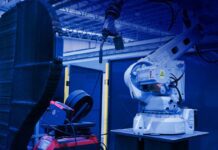Mechanical engineers in the Creative Machines Lab at Columbia University have designed a 3D printing system that constructs cheesecake from edible food inks — including peanut butter, Nutella, and strawberry jam.
In a research published Tuesday in the journal npj Science of Food, the authors pointed out that precise printing of multi-layered food products could result in more individualised foods, enhance food safety, and make it simpler for users to manage the nutrient content of meals.
To demonstrate the potential of 3D food printing, the team experimented with different cheesecake designs that included seven important ingredients: graham cracker, peanut butter, Nutella, banana puree, strawberry jam, cherry drizzle, and frosting.
They discovered that the most successful design used a graham cracker as the core element for each tier of the cake.
Peanut butter and Nutella worked best as supporting layers, forming “pools” to retain the softer elements, banana and jam.
For a successful multi-ingredient layered print, multi-tiered structures with comparable principles to building architectures were required; additional structural parts were required to support softer substrates, the researchers said.
“Because 3D food printing is still a nascent technology, it needs an ecosystem of supporting industries such as food cartridge manufacturers, downloadable recipe files, and an environment in which to create and share these recipes,” explained Jonathan Blutinger, the lead author and a postdoctoral fellow in the lab.
“Its customisability makes it particularly practical for the plant-based meat market, where texture and flavour need to be carefully formulated to mimic real meats,” Blutinger added.
Professor Christen Cooper, from the Pace University Nutrition and Dietetics, noted the low nutritious value of processed foods is a huge problem, pointing out that 3D food printing will still produce processed foods, but for some people, this could mean improved control and tailoring of nutrition–personalised nutrition.
“It may also be useful in making food more appealing to those with swallowing disorders by mimicking the shapes of real foods with the pureed texture foods that these patients–millions in the U.S. alone–require,” the professor stated.
Meanwhile, lab director Professor Hod Lipson, said the study also emphasises that printed food dishes will most likely necessitate novel ingredient compositions and structures, owing to the different way the food is ‘assembled.’
“Much work is still needed to collect data, model, and optimise these processes,” Prof Lipson noted.



















